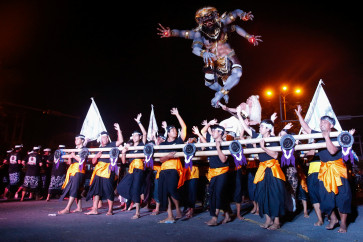Arak makers continue production despite poisoning
Despite the recent wave of alcohol poisoning that has claimed 18 lives, a Balinese arak maker said he would continue producing the liquor, claiming it was his sole source of income
Change text size
Gift Premium Articles
to Anyone

D
espite the recent wave of alcohol poisoning that has claimed 18 lives, a Balinese arak maker said he would continue producing the liquor, claiming it was his sole source of income.
He also guaranteed his arak was "pure" and would not "cause anything bad" to drinkers, except intoxication.
"If you drink a large quantity of arak, of course you will get drunk," said the 48-year-old Ketut Sukerena.
Arak, produced by distilling fermented rice or the sap of coconut palms, sugar palms or lontar palms. Laboratory tests have confirmed that arak oplosan - arak mixed with dangerous substances, primarily methanol - is the culprit behind the slew of poisonings.
Sukerena, a resident of Bondalem village in an arid part of the island's northern coastal regency of Buleleng, said dozens of households in the village relied on arak production as their primary source of income.
"Our arak is not lethal, nobody has ever died because of drinking it," he said.
Sukerena lives with his wife, Luh Sisiani, in a rustic house with a spacious yard, where seven lontar palm trees stand tall. The trees yield the sap, the primary ingredient for Sukerena's arak.
Producing arak is no easy job, he pointed out. Each morning, he has to climb the 20-meter-tall trees and collect the sap. Another exhausting climbing session takes place in the early evening.
"You need physical fitness and courage to climb up and down those tall trees over and over again," he said.
His wife is responsible for processing the sap, cooking it with several ingredients to enhance its flavor before distilling the liquid. The distillation process takes five hours.
Each day, the family business produces up to seven bottles of arak. Each bottle sells for Rp 3,500, giving the family a daily income of Rp 24,500. The price has not been affected yet by the scare over the mass poisonings.
Sukerena said the income was small compared to the efforts he and his wife made during the production process. But he added he had no alternative source of income, with the land too arid for growing crops, and the couple too old to work as laborers, the common job for the village's youths.
He claimed his arak had an alcohol content of 10 percent, and was a safe liquor to consume, but said many arak makers produced arak with higher alcohol levels.
"Some even have similar levels of alcohol as methanol. When you light it with a match, the liquid bursts into flame," he said.
Methanol, locally known as spiritus, is a clear blue liquid used by Balinese in rural areas to light pump lanterns.
Mixing arak with other substances to drastically increase its potency has become a widespread practice among the island's youths. The resulting arak oplosan provides the youths with a faster way to get drunk, and is a much cheaper alternative to beer and imported liquor.









